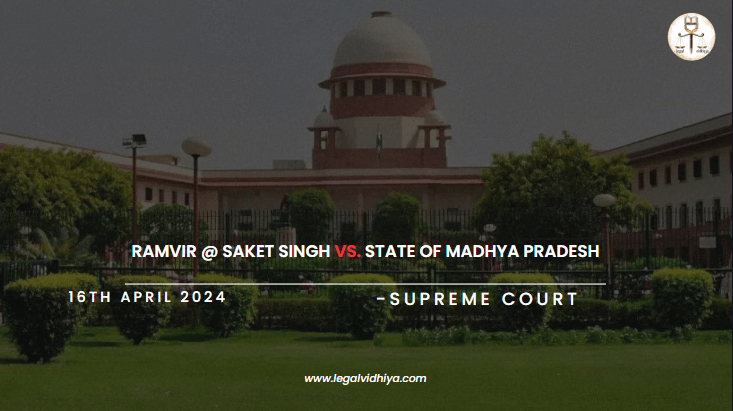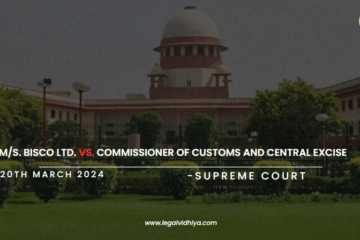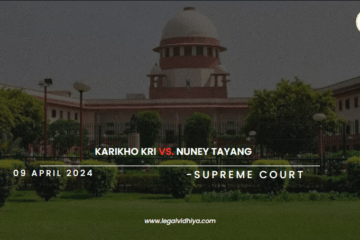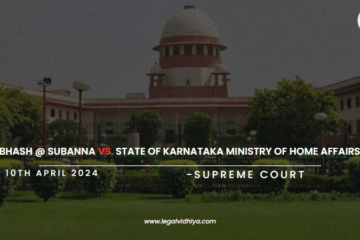
| CITATION | 2024 INSC 308 |
|---|---|
| DATE OF JUDGMENT | 16th April 2024 |
| COURT | Supreme Court of India |
| APPELLANT | Ramvir @ Saket Singh |
| RESPONDENT | The State of Madhya Pradesh |
| BENCH | Justice B.R. Gavai and Justice Sandeep Mehta |
INTRODUCTION
This case involves the appeal of Ramvir @ Saket Singh against the judgment rendered by the Madhya Pradesh High Court, which upheld his conviction for the 1985 murder of Kaptan Singh and the attempted murder of Indal Singh. The trial court had originally sentenced him to life imprisonment in 1998. The appellant contended that the prosecution’s case was fabricated and marred by inconsistencies. However, the Supreme Court, focusing on the reliability of eyewitness testimonies and the corroboration provided by medical evidence, dismissed these claims. The Court emphasized that minor contradictions could not invalidate the overall prosecution case, leading to the affirmation of the appellant’s conviction under Sections 302 and 307 of the Indian Penal Code.
FACTS OF THE CASE
- The case involves the appeal filed by Ramvir @ Saket Singh (referred to as the appellant) against the judgment dated 27th July 2007 passed by the Division Bench of the High Court of Madhya Pradesh at Gwalior.
- The High Court had dismissed the appellant’s appeal against the judgment and order dated 9th November 1998 passed by the Vth Upper Sessions Judge, Bhind, Madhya Pradesh (referred to as the trial Court) in Session Case No. 70 of 1987.
- The trial court had convicted and sentenced the appellant for the murder of Kaptan Singh and the attempted murder of Indal Singh (PW-12).
- The incidents occurred on 10th November 1985 in village Bhajai, District Bhind, Madhya Pradesh.
- The appellant was tried for the murders of Kaptan Singh and Kalyan Singh in two separate incidents, and for the attempted murder of Indal Singh in the incident where Kaptan Singh was killed.
ISSUES RAISED
- Whether the prosecution’s case is based on false and fabricated evidence?
- Whether the appellant can be acquitted based on the right of private defense?
- Whether the eyewitness testimonies provided by the prosecution are reliable and credible?
- Whether the trivial contradictions cited by the defense are sufficient to discard the entire prosecution’s case?
CONTENTIONS OF APPELLANT
- The appellant contended that the entire prosecution case was fabricated, arguing that the fatal injuries sustained by two members of their party were not adequately explained by the prosecution witnesses.
- They asserted that inconsistencies in the prosecution’s narrative warranted acquittal, citing the acquittal of the complainant party in a related case as a basis for their own acquittal.
- The appellant challenged the credibility of key prosecution witnesses, alleging bias due to their close relationship with the deceased, and argued that the testimonies lacked corroboration and should not be accepted as sole evidence.
- Additionally, the appellant claimed that their actions were in self-defense, suggesting that the complainant party were the aggressors.
- They pointed out the absence of empty cartridges at the place of the incident and raised a plea of alibi, arguing that these contradictions were significant enough to discard the prosecution’s case.
- Furthermore, the appellant highlighted that they had already served 14 years of substantive imprisonment and nearly 22 years with remission, and implored the Court to consider this in their appeal and acquit them of the charges.
CONTENTIONS OF REPONDENT
- The respondents contended that the prosecution’s case was neither false nor fabricated.
- They argued that the eyewitness testimonies, particularly that of Indal Singh, provided a consistent narrative of the events leading to the crimes.
- The respondents stressed that the testimonies were credible and trustworthy, backed by medical evidence and circumstantial details.
- They refuted the appellant’s claim that the complainant party were the aggressors, citing the outcome of a related cross-case where members of the appellant’s party were found to be the aggressors.
- The respondents highlighted the absence of injuries on the appellant despite the alleged crossfire, suggesting discrepancies in the appellant’s version of events.
- They argued that the evidence presented, including the testimony of witnesses and medical reports, collectively pointed towards the guilt of the appellant.
- The respondents asserted that minor contradictions raised by the defense were trivial and did not undermine the reliability of the prosecution’s evidence.
- They emphasized that the gruesome nature of the daylight double murder made it unlikely that neutral witnesses would come forward, reinforcing the credibility of the prosecution witnesses.
JUDGEMENT
The Supreme Court, after a thorough analysis of the evidence and arguments presented, upheld the conviction of Ramvir @ Saket Singh for the murder of Kaptan Singh and the attempted murder of Indal Singh. The Court noted that the trial court’s 1998 judgment, which sentenced the appellant to life imprisonment, was rightly affirmed by the Madhya Pradesh High Court. The Supreme Court emphasized that the prosecution’s case was substantiated by reliable eyewitness testimonies, particularly those of Indal Singh and Raj Kumari, and supported by medical evidence.
The Court addressed the appellant’s contention that the prosecution’s witnesses were biased due to their close relationship with the deceased. It ruled that their testimonies were consistent and credible, and minor contradictions cited by the defense were insufficient to undermine the prosecution’s case. The plea of alibi and the absence of empty cartridges at the crime scene were dismissed as trivial issues that did not affect the overall reliability of the evidence.
Moreover, the Supreme Court dismissed the defense’s argument that the appellant had already served a significant portion of his sentence. It reiterated that justice must be served in accordance with the law, regardless of the time already spent in imprisonment. Consequently, the appeal was rejected, and the conviction under Sections 302 and 307 of the IPC was upheld, reaffirming the appellant’s life sentence. This judgment highlights the Court’s dedication to upholding justice through careful consideration of all aspects of the case.
ANALYSIS
In a landmark ruling, the Supreme Court upheld the conviction in a four-decade-old murder case, emphasizing that minor contradictions cannot undermine the entire prosecution’s case. The trial court had convicted Ramvir @ Saket Singh in 1998 for the 1985 murder of Kaptan Singh and the attempted murder of Indal Singh, sentencing him to life imprisonment. This decision was affirmed by the Madhya Pradesh High Court. Justices B.R. Gavai and Sandeep Mehta noted that the trivial contradictions highlighted by the defense, such as the absence of empty cartridges at the crime scene and the plea of alibi, were insufficient to discredit a prosecution case backed by reliable eyewitnesses and corroborated by medical evidence and other circumstances.
Senior Advocate P.H. Parekh, representing the appellant, argued that the prosecution witnesses were biased due to their close relationship with the deceased and lacked corroboration. The appellant, having already endured 14 years of substantive imprisonment and nearly 22 years with remission, sought acquittal based on these grounds. However, the Supreme Court dismissed these arguments, stating that in a case involving a gruesome daylight double murder, it was unlikely that neutral witnesses would come forward. The Court underscored the credibility of the eyewitness testimonies and the lack of substantial contradictions in their accounts, thereby affirming the trial court’s judgment and dismissing the appeal.
CONCLUSION
In conclusion, the Supreme Court’s decision to uphold the conviction of Ramvir @ Saket Singh underscores the judiciary’s commitment to ensuring justice through meticulous evaluation of evidence. Despite the appellant’s arguments regarding the credibility of prosecution witnesses and alleged inconsistencies, the Court found the eyewitness testimonies and corroborating medical evidence to be reliable and compelling. The Court dismissed the appeal, highlighting that minor contradictions could not overshadow the robust evidence presented by the prosecution. This case reaffirms the importance of thorough judicial scrutiny in upholding the rule of law and delivering justice, even in cases spanning several decades.
REFERENCES
This Article is written by Poorna.R student of School of Excellence in Law, Chennai; Intern at Legal Vidhiya.
Disclaimer: The materials provided herein are intended solely for informational purposes. Accessing or using the site or the materials does not establish an attorney-client relationship. The information presented on this site is not to be construed as legal or professional advice, and it should not be relied upon for such purposes or used as a substitute for advice from a licensed attorney in your state. Additionally, the viewpoint presented by the author is of a personal nature.




0 Comments